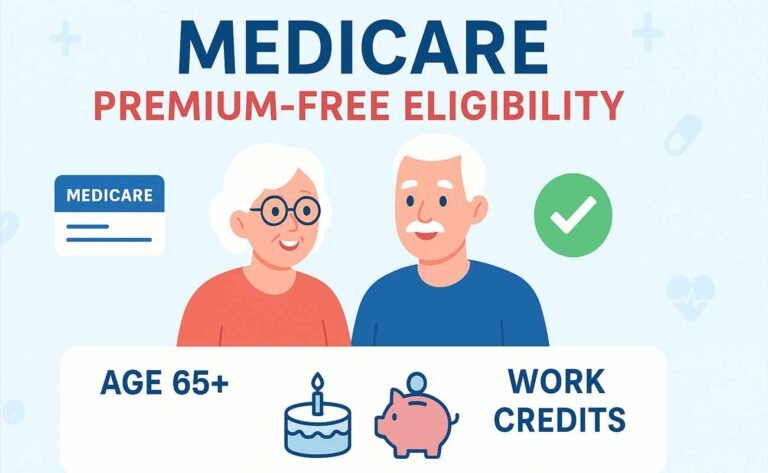Medicare Part A, B, C, D Benefits for Seniors Explained: Coverage, Costs, and Key Differences
What Is Medicare? A Quick Overview
Medicare is a federal health insurance program primarily for individuals aged 65 and older, offering coverage for hospital stays, doctor visits, preventive care, and prescription drugs. Part A covers inpatient hospital care, Part B handles outpatient services, Part C (Medicare Advantage) combines A and B with additional benefits, and Part D focuses on prescription drugs. Each part has unique costs, eligibility criteria, and coverage details, making it essential to understand their distinctions to choose the right plan. This guide breaks down Medicare Parts A, B, C, and D, detailing their coverage, costs, and key differences in clear lists and tables to help seniors make informed decisions.
With rising healthcare costs, selecting the right Medicare plan is crucial for financial and medical security. Whether you’re enrolling for the first time or reassessing your options during the Annual Enrollment Period (October 15–December 7), understanding these components ensures you get the coverage you need without unexpected expenses. Below, we’ll explore each part in depth, ensuring high readability and incorporating related terms like Medicare Advantage, prescription drug coverage, and out-of-pocket costs.
Medicare Part A: Hospital Insurance for Seniors
Medicare Part A is often called “hospital insurance” because it covers inpatient care and related services. Most seniors qualify for premium-free Part A if they or their spouse paid Medicare taxes for at least 10 years (40 quarters) while working. For those who don’t qualify, premiums can be costly, making it critical to understand eligibility.
Coverage Details for Medicare Part A
- Inpatient Hospital Stays: Includes semi-private rooms, meals, general nursing, and medications during your stay (up to 90 days per benefit period, with additional lifetime reserve days).
- Skilled Nursing Facility Care: Covers rehabilitation services after a qualifying hospital stay (at least 3 days), limited to 100 days per benefit period.
- Hospice Care: For terminally ill patients with a life expectancy of six months or less, including pain relief and support services.
- Home Health Services: Limited to medically necessary part-time care, like physical therapy or skilled nursing at home.
- Blood: Covers blood transfusions during hospital stays, though you may pay for the first three pints.
Costs Associated with Medicare Part A (2025)
| Service | Cost |
|---|---|
| Premium | $0 for most (if worked 40 quarters); $506/month for <30 quarters; $278/month for 30–39 quarters |
| Deductible | $1,632 per benefit period (hospital stays) |
| Coinsurance (Hospital Stay) | $0 for days 1–60; $408/day for days 61–90; $816/day for lifetime reserve days |
| Skilled Nursing Facility | $0 for days 1–20; $204/day for days 21–100 |
| Hospice Care | $0 for most services; $5 copay for prescription drugs; 5% for respite care |
| Home Health Services | $0 for covered services |
Key Considerations
- Enrollment: Automatic for those receiving Social Security benefits at 65; others must enroll during the Initial Enrollment Period (IEP), which spans three months before and after your 65th birthday.
- Late Enrollment Penalty: Applies if you don’t qualify for premium-free Part A and fail to enroll during your IEP (1% monthly premium increase for each year delayed).
- Benefit Period: Starts when admitted to a hospital and ends when you haven’t received inpatient care for 60 consecutive days.
For more on managing healthcare costs, check out Medicare.gov, the official resource for Medicare information.
Medicare Part B: Medical Insurance for Outpatient Care
Medicare Part B covers outpatient medical services, such as doctor visits and preventive care. Unlike Part A, everyone pays a monthly premium for Part B, and costs can vary based on income. It’s optional but highly recommended to avoid gaps in coverage for routine medical needs.
Coverage Details for Medicare Part B
- Doctor Visits: Includes consultations, specialist visits, and outpatient procedures.
- Preventive Services: Annual wellness visits, screenings (e.g., mammograms, colonoscopies), and vaccinations (e.g., flu shots).
- Outpatient Care: Diagnostic tests, X-rays, and lab work performed outside a hospital.
- Durable Medical Equipment (DME): Wheelchairs, walkers, and oxygen equipment.
- Mental Health Services: Counseling and therapy sessions.
- Ambulance Services: Emergency transport when medically necessary.
Costs Associated with Medicare Part B (2025)
| Service | Cost |
|---|---|
| Standard Premium | $185/month (higher for high-income earners via IRMAA) |
| Deductible | $252/year |
| Coinsurance | 20% of Medicare-approved amount after deductible |
| Preventive Services | $0 for most covered services |
| Durable Medical Equipment | 20% of Medicare-approved amount |
Key Considerations
- Income-Related Monthly Adjustment Amount (IRMAA): Higher earners (e.g., individuals with income >$103,000 or couples >$206,000) pay additional premiums.
- Enrollment: Like Part A, automatic for Social Security recipients; others enroll during IEP.
- Late Enrollment Penalty: 10% premium increase for each 12-month period you were eligible but didn’t enroll, lasting for as long as you have Part B.
Medicare Part C: Medicare Advantage Plans
Medicare Part C, or Medicare Advantage, is an alternative to Original Medicare (Parts A and B). Offered by private insurers approved by Medicare, these plans bundle Part A, Part B, and often Part D coverage, sometimes adding extras like dental or vision. However, they come with network restrictions and varying costs.
Coverage Details for Medicare Advantage
- Core Coverage: Includes all Part A and B services (hospital and medical care).
- Additional Benefits: May include dental, vision, hearing, gym memberships, or transportation to medical appointments.
- Prescription Drugs: Most plans include Part D coverage, but confirm with the plan provider.
- Out-of-Pocket Maximum: Caps annual spending (e.g., $8,850 in-network for 2025), unlike Original Medicare.
Costs Associated with Medicare Part C (2025)
| Cost Type | Details |
|---|---|
| Premium | Varies ($0–$200+/month) in addition to Part B premium |
| Deductible | Varies by plan (some have $0 deductibles) |
| Copays/Coinsurance | Varies (e.g., $20/visit for doctors, $50 for specialists) |
| Out-of-Pocket Maximum | Up to $8,850/year (in-network); higher for out-of-network services |
Types of Medicare Advantage Plans
- Health Maintenance Organization (HMO): Requires in-network providers and primary care physician referrals.
- Preferred Provider Organization (PPO): Offers more flexibility with out-of-network providers at higher costs.
- Private Fee-for-Service (PFFS): Allows any provider accepting the plan’s terms.
- Special Needs Plans (SNPs): Tailored for chronic conditions or specific groups (e.g., dual-eligible for Medicare and Medicaid).
Key Considerations
- Network Restrictions: HMOs and PPOs limit provider choices; check if your doctors are in-network.
- Annual Changes: Plans can change coverage, costs, or networks yearly, so review during the Annual Enrollment Period.
- Star Ratings: CMS rates plans (1–5 stars) based on quality; higher-rated plans often provide better service.
For insights on supplemental financial support, explore Social Security Payment 2025 Calendar to align Medicare costs with your benefits schedule.
Medicare Part D: Prescription Drug Coverage
Medicare Part D provides prescription drug coverage through private insurers. It’s optional but vital for seniors relying on medications, as Original Medicare doesn’t cover most prescriptions. Plans vary widely in terms of covered drugs and costs.
Coverage Details for Medicare Part D
- Prescription Drugs: Covers a formulary (list of covered medications) that varies by plan.
- Tiers: Drugs are grouped into tiers (e.g., generic, brand-name), with higher tiers costing more.
- Pharmacy Network: Preferred pharmacies offer lower copays; check network restrictions.
Costs Associated with Medicare Part D (2025)
| Cost Type | Details |
|---|---|
| Premium | $0–$100+/month (varies by plan; higher for high-income earners via IRMAA) |
| Deductible | Up to $590/year (some plans have $0 deductibles) |
| Copays/Coinsurance | Varies by drug tier (e.g., $5–$50 for generics, 25%–50% for brand-name) |
| Coverage Gap (Donut Hole) | Begins after $5,030 in total drug costs; you pay 25% of costs until $8,000 |
| Catastrophic Coverage | After $8,000, you pay $0 for covered drugs |
Key Considerations
- Formulary Changes: Plans update drug lists annually; review during the Annual Enrollment Period.
- Late Enrollment Penalty: 1% of the national average premium ($35.63 in 2025) per month delayed, added to your premium permanently.
- Extra Help Program: Low-income seniors may qualify for subsidies to reduce Part D costs. Visit CMS.gov for eligibility details.
Key Differences Between Medicare Parts A, B, C, and D
To make an informed choice, understanding how Parts A, B, C, and D differ is crucial. Below is a detailed comparison table:
| Feature | Part A | Part B | Part C (Medicare Advantage) | Part D |
|---|---|---|---|---|
| Coverage Type | Hospital insurance | Medical insurance | All-in-one (A, B, often D) | Prescription drugs |
| Services Covered | Inpatient stays, hospice | Doctor visits, preventive care | A, B, plus extras (e.g., dental) | Medications |
| Premium | $0 for most; up to $506 | $185 (varies by income) | Varies ($0–$200+) | $0–$100+ |
| Deductible | $1,632 per benefit period | $252/year | Varies by plan | Up to $590/year |
| Coinsurance/Copays | Varies by service | 20% after deductible | Varies by plan | Varies by drug tier |
| Provider Choice | Any Medicare-accepting provider | Any Medicare-accepting provider | Network restrictions (HMO/PPO) | Pharmacy network restrictions |
| Out-of-Pocket Maximum | None | None | Yes (e.g., $8,850 in-network) | None (catastrophic coverage) |
Choosing the Right Medicare Plan for Seniors
Selecting the right Medicare plan depends on your health needs, budget, and lifestyle. Here’s a step-by-step guide to help you decide:
- Assess Your Healthcare Needs:
- List your regular medications, doctors, and medical conditions.
- Estimate frequency of doctor visits, hospital stays, or specialist care.
- Compare Original Medicare vs. Medicare Advantage:
- Original Medicare (A + B): Ideal for those wanting flexibility in provider choice but requires supplemental insurance (Medigap) to cover gaps.
- Medicare Advantage: Suits those seeking all-in-one coverage with extras, but check network restrictions.
- Evaluate Prescription Drug Needs:
- If you take multiple medications, prioritize a robust Part D plan or a Medicare Advantage plan with drug coverage.
- Use the Medicare Plan Finder tool on Medicare.gov to compare Part D plans.
- Consider Your Budget:
- Factor in premiums, deductibles, copays, and potential out-of-pocket costs.
- Explore low-income assistance programs like Extra Help for Part D.
- Review Annually:
- Plans change yearly, so reassess during the Annual Enrollment Period to ensure your plan still meets your needs.
Common Questions About Medicare for Seniors
1. Can I Have Both Original Medicare and Medicare Advantage?
No, you must choose one. Enrolling in a Medicare Advantage plan replaces Original Medicare, though you still pay the Part B premium.
2. What Is Medigap?
Medigap is supplemental insurance for Original Medicare to cover costs like coinsurance and deductibles. It’s not compatible with Medicare Advantage.
3. How Do I Avoid Late Enrollment Penalties?
Enroll during your IEP (three months before and after turning 65) or during a Special Enrollment Period if you have qualifying circumstances (e.g., employer coverage).
4. Are There Financial Assistance Programs?
Yes, programs like Extra Help and Medicaid assist low-income seniors. Check eligibility at CMS.gov.
Tips for Maximizing Medicare Benefits
- Leverage Preventive Services: Take advantage of free screenings and wellness visits under Part B to catch issues early.
- Compare Plans Annually: Use the Medicare Plan Finder to ensure your plan aligns with your medications and providers.
- Understand Your Rights: You can appeal denied claims or switch plans during enrollment periods.
- Combine with Other Benefits: Programs like Colorado TABOR Refund for Seniors can ease financial burdens.
Conclusion
Understanding Medicare Part A, B, C, and D empowers seniors to make informed healthcare decisions. Part A ensures hospital care, Part B covers outpatient services, Part C offers a bundled alternative, and Part D addresses prescription drug needs. By comparing coverage, costs, and provider flexibility, you can tailor your plan to your health and financial situation. Use tools like the Medicare Plan Finder and consult resources like Medicare.gov to stay updated. With careful planning, Medicare can provide comprehensive coverage, giving you peace of mind in your golden years.






